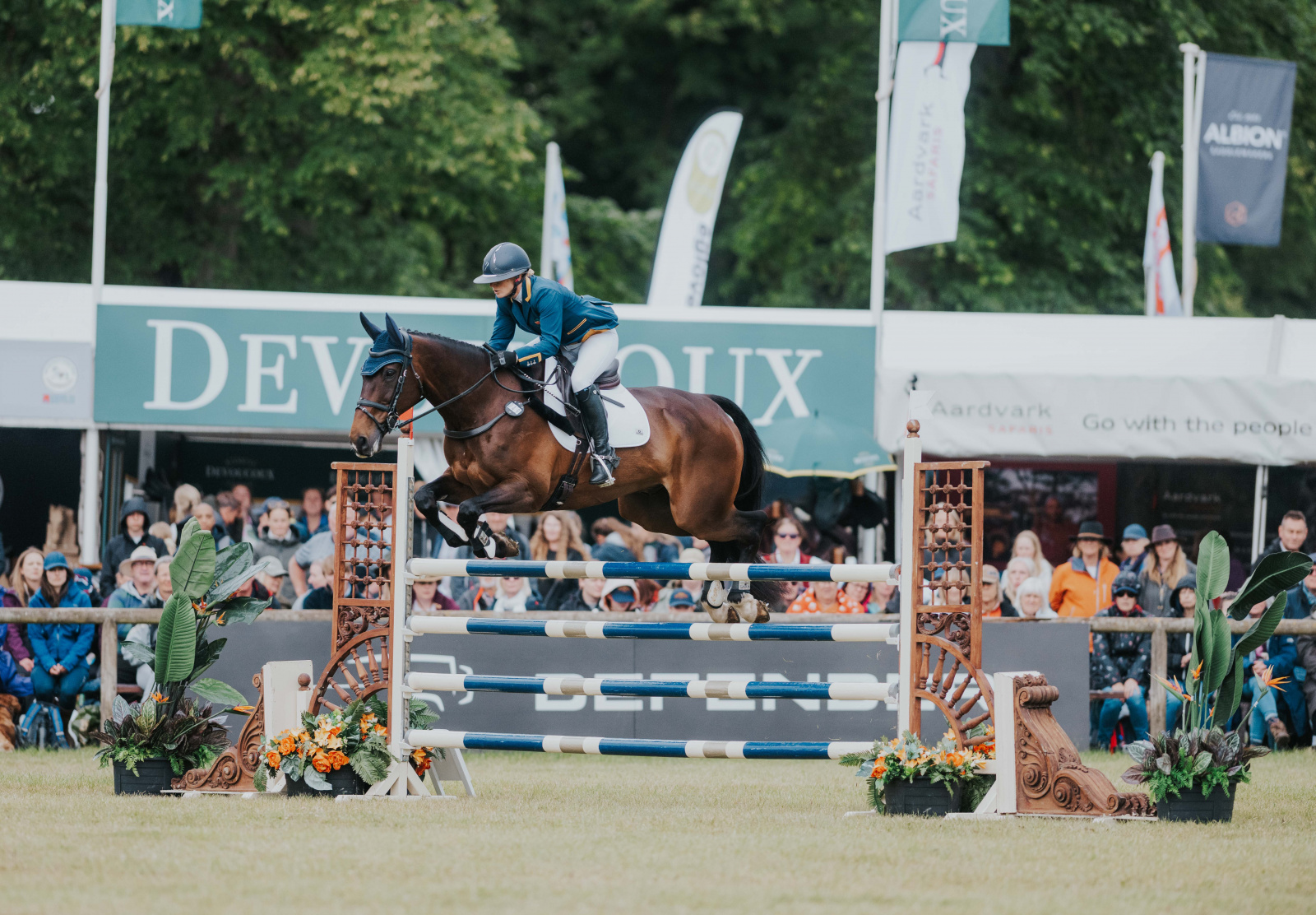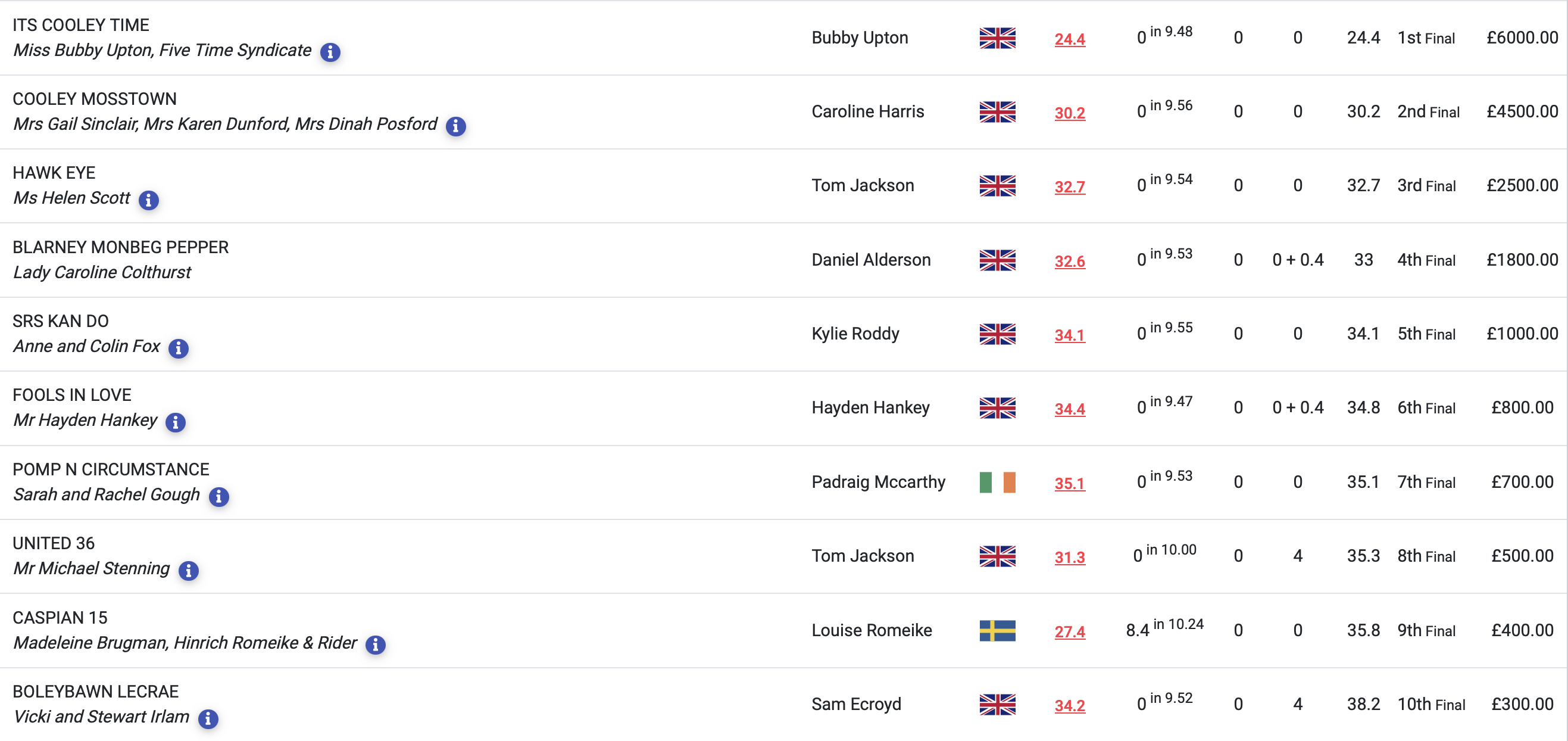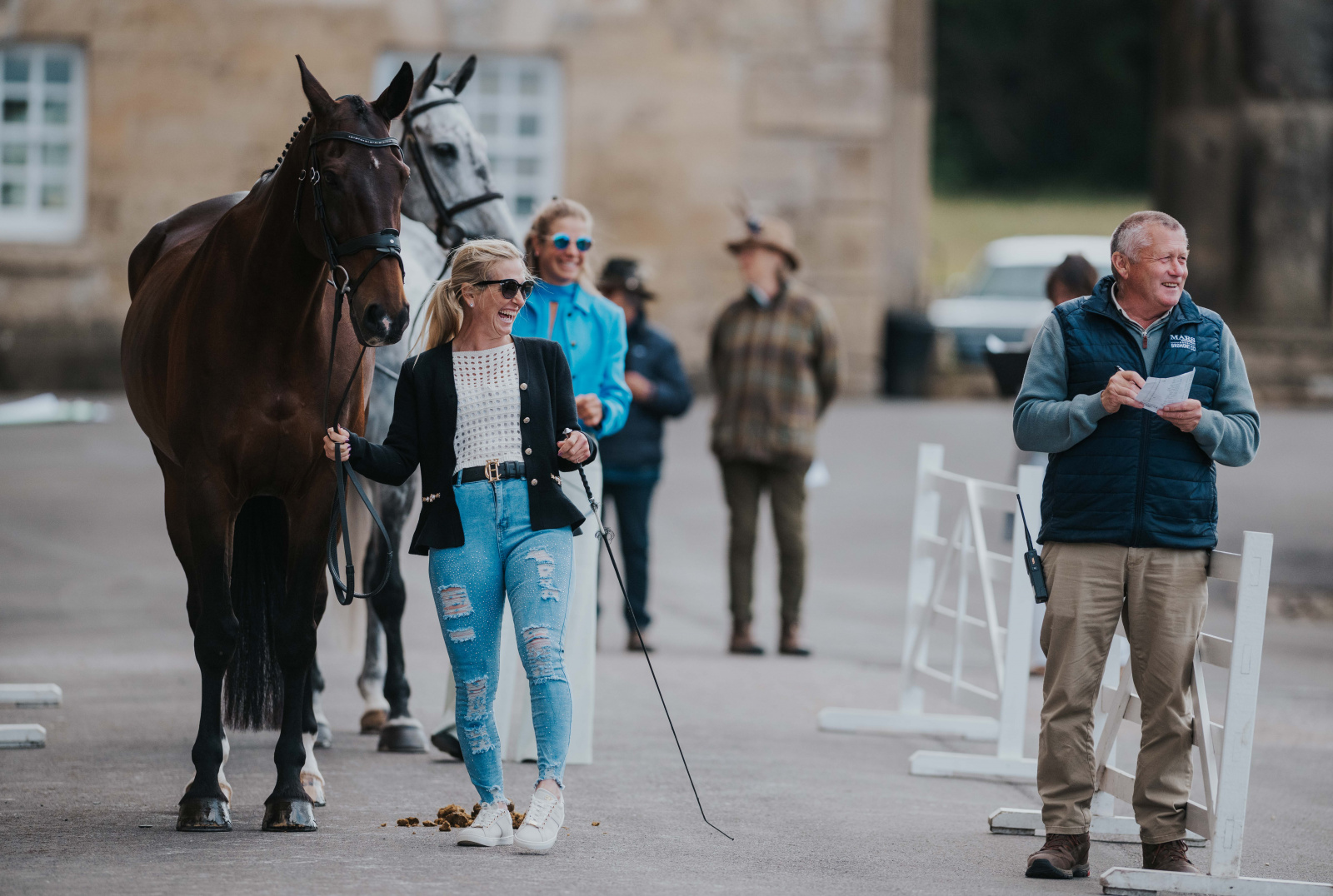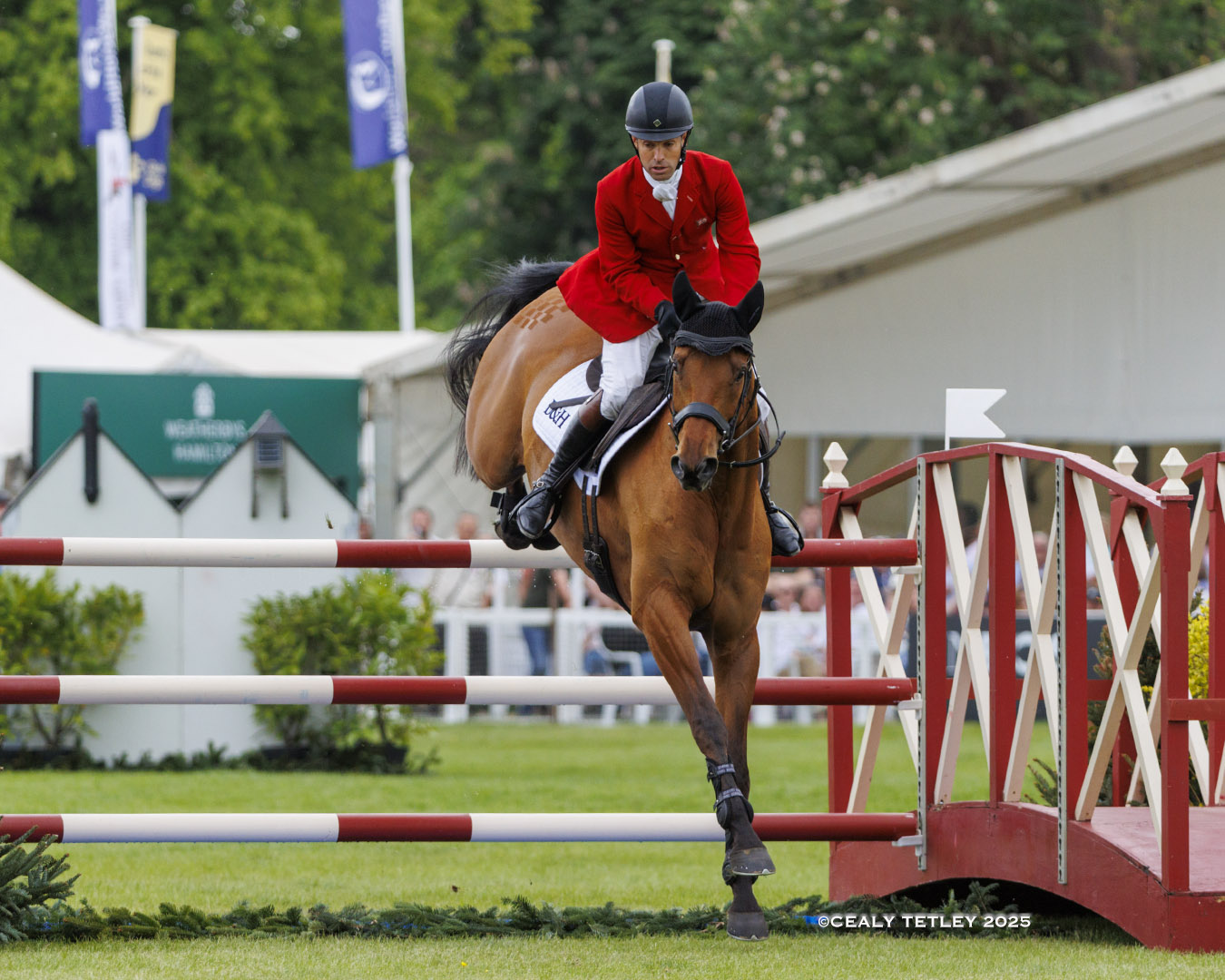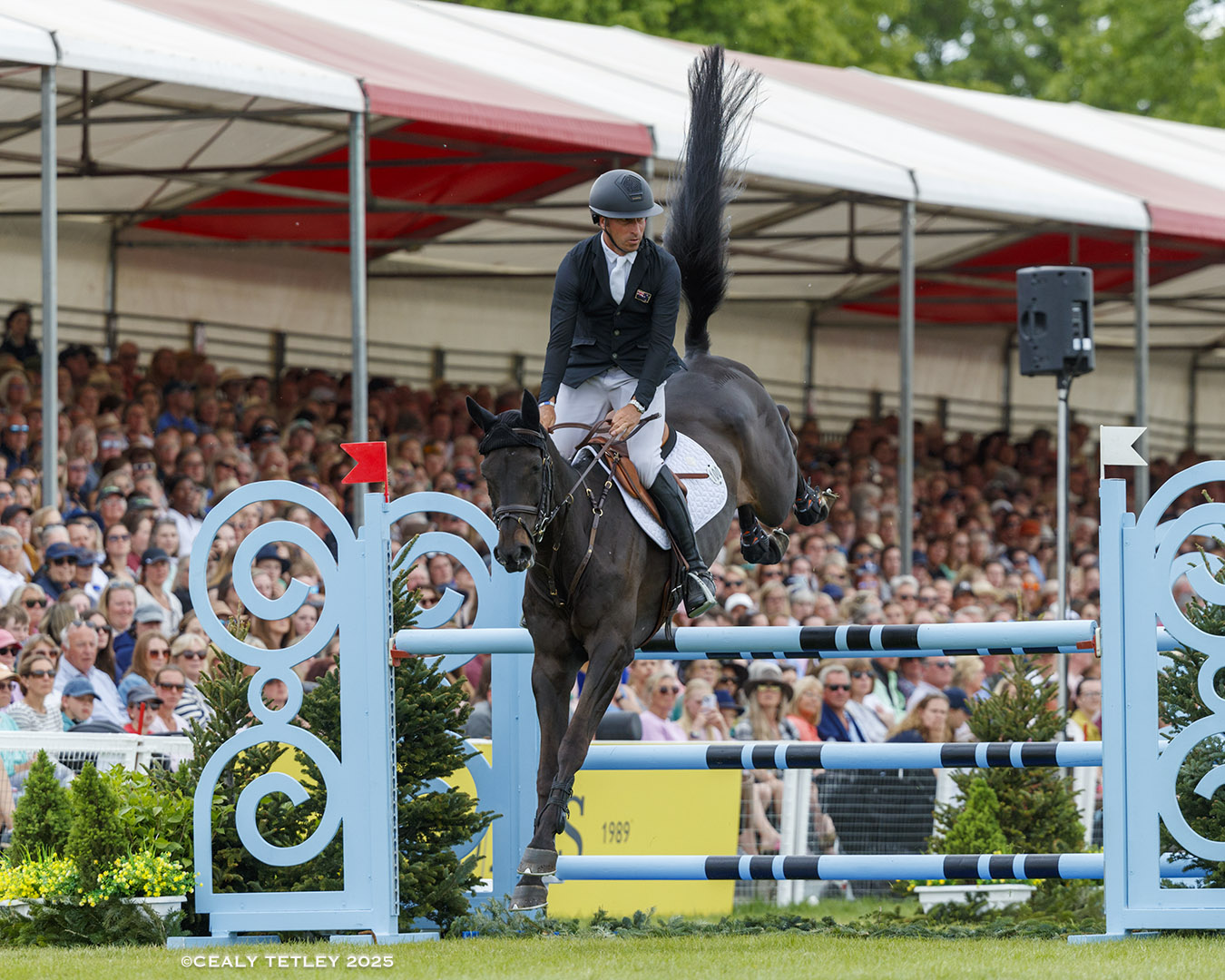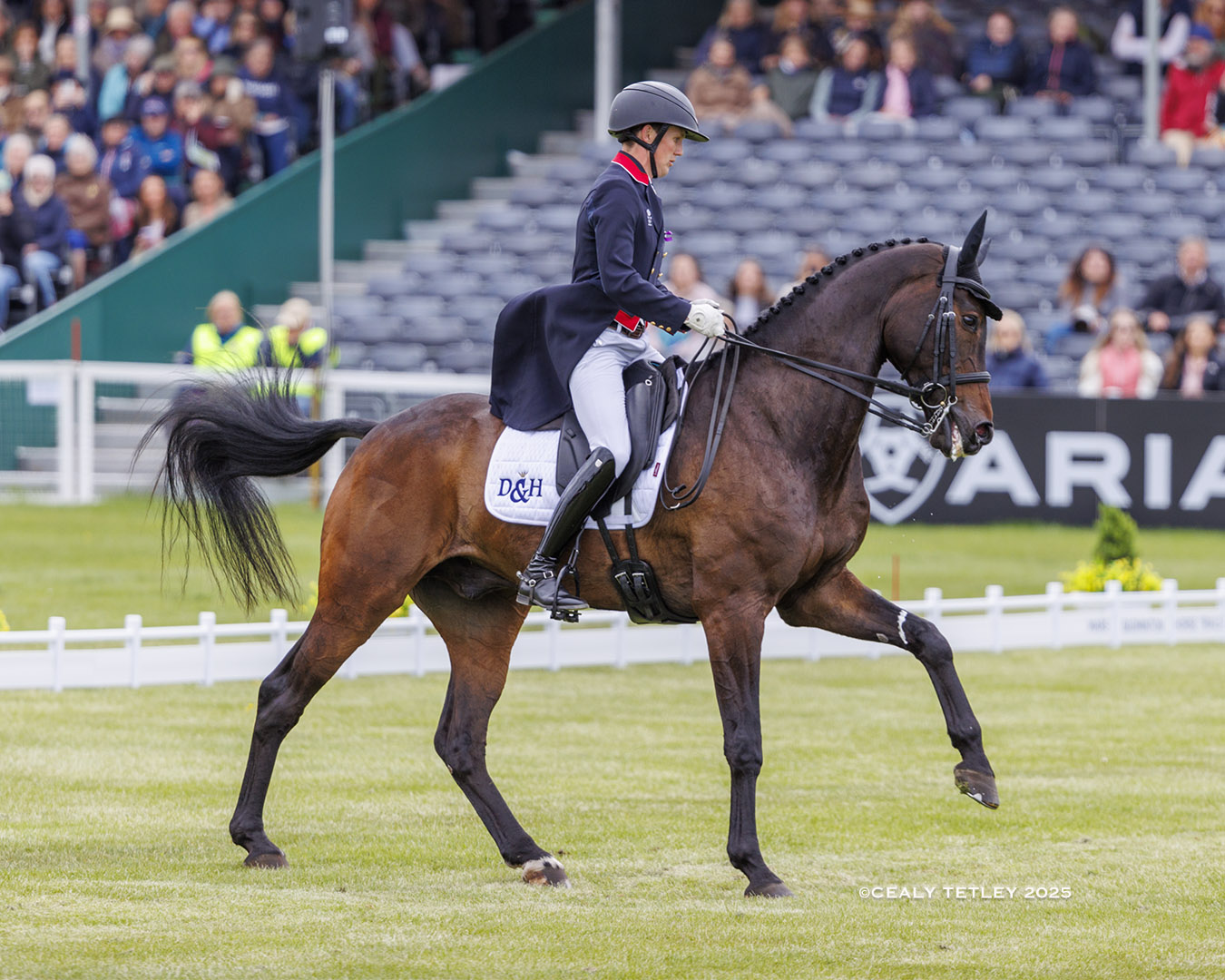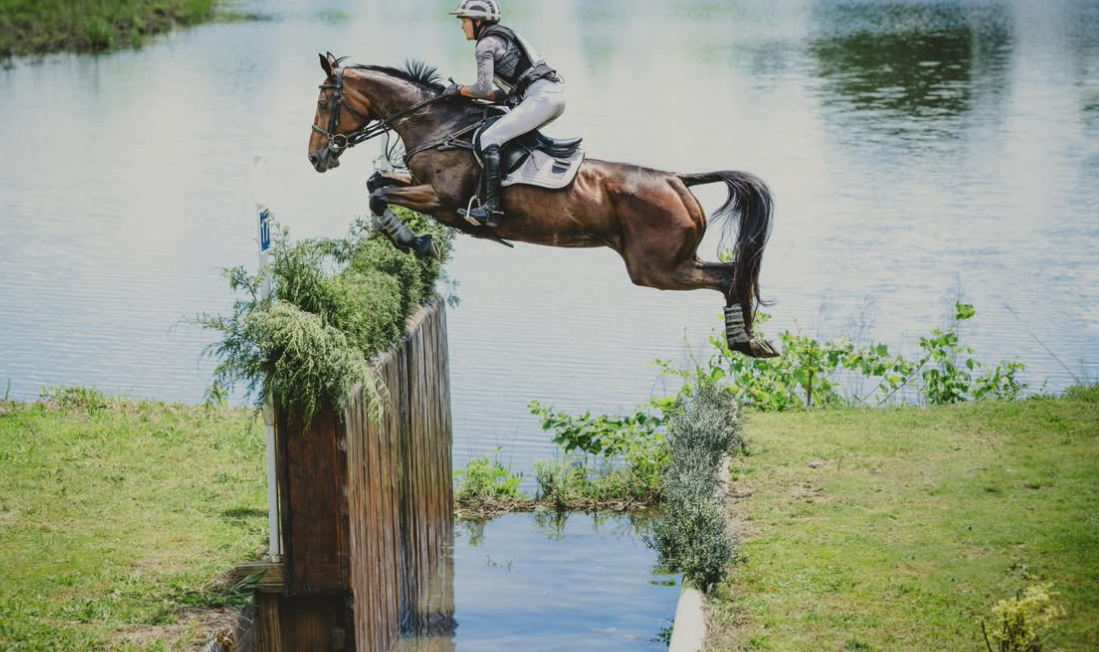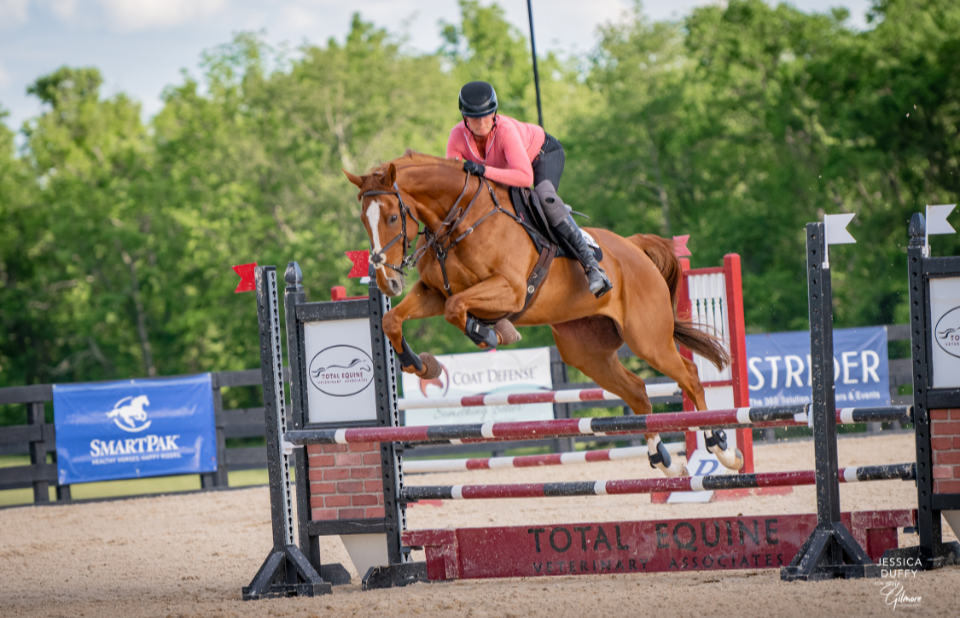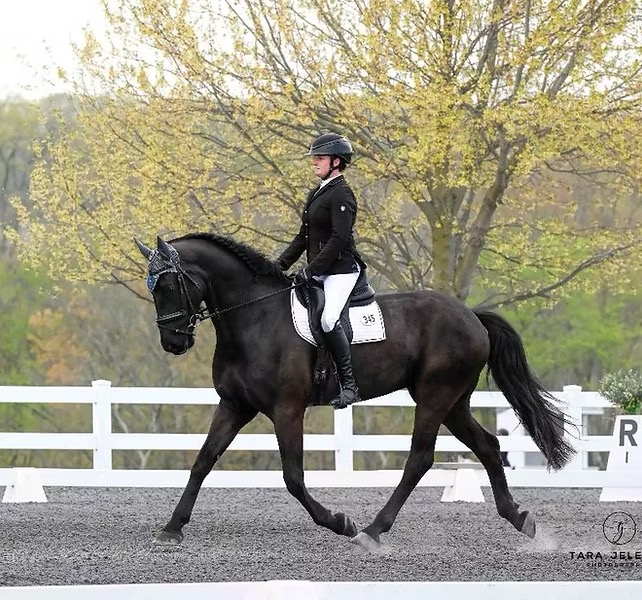
Phoebe Locke and Ballagio Declyange pop down the new Irish bank. Photo by Tilly Berendt.
Woe betide anybody who continues to repeat the tired opinion that Luhmühlen is a ‘soft’ CCI5*. Dimensionally? No, it’s not maxed out. Length-wise? It’s unlikely you’ll ever see a nearly thirteen minute course here. Terrain? Pretty flat, actually. But it’s a course that’s greater than the sum of its parts: an academic, thinking rider’s track, with plenty of places to have drive-by and lots of places to lose valuable fistfuls of seconds.
Maybe course designer Mike Etherington-Smith felt he had a point to prove in defence of his event this year — after all, he’d admitted in a course preview for the show that he’d felt last year’s track was too soft, with its four inside the time and 51% clear rate. (The average at five-star, for what it’s worth, hovers around 56%.)
Whatever his motivation, he went to the drawing board as a man on a mission, firstly flipping the direction of the track — a move he last made in 2022 — to its more intense clockwise route (well, as much as you can consider anything clockwise or counterclockwise on a course that spirals around itself as much as this one does). He also got to work with his team of groundsmen and builders and, one presumes, a digger, finally installing the Irish bank he’s long dreamed of and argued for. And he took the already tough early combinations — the dappled Longines Water at 4 and 5ABC, the three-part angled question in the main arena at 8ABC — and made them even more acute and exacting, challenging riders on fit, fresh, strong horses to dig deep and find something like rideability somewhere in their partners.
It was those two combinations that I’d flagged early on as potentially very influential ones — but, I’ll confess, it was that water complex at 4 and 5ABC that I really thought would ultimately be the bogey of the day. It followed on from three very straightforward, not at all big fences, which were then left behind by one of the longest galloping stretches on the course. Then, horses and riders had to negotiate a steep downhill approach to a roll top at 4, before turning to a huge brush drop into the water at 5A, an angled boat in the water at 5B, and an angled brush on dry land at 5C. There’s terrain, there’s crowds, there’s tricky dappled lighting, there’s a line there that I walked several times and still couldn’t ever actually see, and it’s the first combination on course, too — surely, I reckoned, this would be the site of a lot of hands in the air and short walks back to the stables throughout the day.
So there was me, worrying about that, and then there was the European-based riders, who were worrying about the Irish bank at 20ABC, and actually, as is often the case at five-star level, we were all completely wrong about both of them. Not a single horse and rider faulted at the first water complex despite everything that made it seem so tricky, and just one competitor ran into problems at the Irish bank. The rest hunted their way through, found their line, and proved Mike right in his convictions that the complex would be a great addition to the course.
Of course, none of us were ever blind to the question in the main arena, which was made up of a wide timber oxer at 8A, followed by two angled hedges — opposing angles at that — after a 90-degree right-handed turn. Luhmühlen’s main arena combination is always influential, and the offset angles on the hedges created a perfect open door for a run-out to the left — an open door that many horses were happy to go through. It walked as one very long stride or two tight ones on a slightly curving line, and neither of them really felt like the right one, and so we knew it would cause problems — we just didn’t really expect 33% of the field to have issues there.
But that’s what happened, as horse after horse skewed out to the left of the C element, and some at the B element. At one point, we were effectively given a long judging break on course because three riders in a row opted to retire there, and by the end of the day, 15 competitors would pick up penalties at one of those two angled hedges.

Ultimately, our starting field of 46 would be whittled down throughout the day to 32 finishers — a 70% completion rate that’s about what we’ve come to expect here. But of those 32 finishers, just 20 completed without adding jumping penalties, giving Luhmühlen’s 2025 track a stiff 43.5% clear rate, nearly eight percent lower than last year and nearly 13% lower than that of Badminton, which saw 56% jump clear.
One thing did remain the same, though: once again, four riders caught the optimum time of 11:02, despite many competitors predicting that the time would be nigh-on uncatchable.

Laura Collett and London 52. Photo by Tilly Berendt.
Chief among those? A familiar face at the business end of the leaderboard in Laura Collett and London 52, who won here two years ago when finishing on their dressage score. Today, they once again added nothing to their first-phase result — a 25.4 earned yesterday afternoon — to continue their bid for a fourth five-star win out of as many starts.
“He’s sensational,” says Laura. “I genuinely have not got enough words. I’m not very good with words, so I can’t do him justice, but he’s insane. The feeling he gives is like no other, so to be in my position and sat on a horse like that is something that I just have to treasure.”

Laura Collett and London 52. Photo by Tilly Berendt.
It feels a very long time since Dan’s wobbly 2019 season, early on in his upper-level career, when he misread a fence in the water at the European Championships here and deposited Laura into the drink. These days, he’s about as reliable as a horse can be, even when the chips are down — something he proved today when he and Laura saw slightly different strides to the double of offset tables at 21AB and had to scramble their way through.
“I rode like a bit of a plonker, to be honest,” she says. “He landed a bit short, and I stupidly still tried to get the three, and it was never there. I don’t know why he landed a bit short; I don’t know what happened, it was just horrible! It wasn’t very nice. Luckily, he’s very scopey and clever with his legs. But that was definitely rider error.”
Other than that little heart-in-mouth moment, though, Laura’s round made the difficult track look like an extended schooling exercise.
“The course it rode like it walked: we said it’s going to ride like a short format from the first water, and it really did. There was nowhere you felt like you could just sit and breathe and gather your thoughts. It was bang, bang, bang — whether it’s turning and twisting through the trees or setting up for a combination. So in that respect, it was exactly as it walked,” she says. “But in everything he does — the way he gallops, the way he listens… He’s a big horse, but he’s so adjustable. He’s so nippy around these tracks, and at the end of the day, he just loves it. He’s so honest, and he looks for the flags, and he makes my job very easy.”

Laura Collett and Hester. Photo by Tilly Berendt.
‘Dan’ was one of the last horses out on the course in this morning’s five-star, and the second of Laura’s rides today: the first, the much less experienced Hester, delivered one of the earliest confidence-boosting rounds of the day as third out of the start box in this morning’s slightly less oppressive heat. It’s a first five-star clear on a third attempt for the thirteen-year-old, who visibly came into her own and grew in confidence as she ticked each fence off on course.
“I went to the stables and I said to Dan, ‘it’d be embarrassing if you let her show you up today!’,” laughs Laura. “She was phenomenal. The improvement in her in 12 months from where she was here last year was amazing. And for me, that’s what it’s all about, is building that partnership. I haven’t had her all the way through like I’ve had Dan, so it’s taken a few years, but she feels amazing. She’s like my little unicorn that I get to fly around on first and she gives me loads of confidence.”

Ros Canter and Izilot DHI. Photo by Tilly Berendt.
With Laura and Dan safely home, all eyes turned to her compatriots and closest challengers, who were following them around the track. But as they passed the middle of the course, last year’s cross-country leaders suddenly had a big question mark over their score: Ros Canter and Izilot DHI had been awarded a provisional flag penalty at the first element of the LeMieux Water at 16A, nixing their chances at trying for the win again.
It must have felt an achingly long few minutes for Ros, whose last year has felt plagued by flags — but the turnaround on the review was among the quickest we’ve seen, and soon, it was confirmed: she would retain her second place, having added just 2.8 time penalties to her dressage score of 26. That, of course, broadens the margin between her and Laura a touch, but at 3.4 penalties, it doesn’t give Laura anything more than time in hand for tomorrow’s showjumping.
Like Laura, Ros had an earlier ride on a less experienced horse in MHS Seventeen, but unlike Laura, that round didn’t go totally to plan — they picked up 20 penalties in the main arena, and a further 20 time penalties, en route to completing. When it was time to leave the start box again, on a perennially sharp-brained horse, she had to put it out of her mind as best she could and focus on riding the horse underneath her.
Then, she says, “he was fantastic — and actually, less spooky than I thought he would be, because the MHS Seventeen horse went out and he was really spooky today, and he’s not normally like that. So I was a little bit concerned that Isaac might come out at his worst. I rode him a little bit earlier this morning, and he wouldn’t go near one of the show jumps, which I was slightly concerned about.
“But when he got out there, he really settled. I think having the woods and the track really channeled at the beginning really helped him. He was a little bit looky at the first water with the people, but, I mean, he ducks and dives all over. Going into the main arena was the worst, and out again, but he knows his stuff now.”

Ros Canter and Izilot DHI. Photo by Tilly Berendt.
As regards her 2.8 time penalties, Ros is pragmatic.
“I always come back and think there’s a few places that I could have maybe got a couple of deeper spots, but you know, we’re talking the odd second,” she says. “You look at Lordships Graffalo, and you can afford to do that and still make the time up, whereas Isaac, bless him — he doesn’t find it so easy to go for so long, which is why he dances so easily in the dressage. So there’s strengths and weaknesses in every horse, but I couldn’t fault his attitude today.”

Sam Lissington and Ricker Ridge Sooty. Photo by Shannon Brinkman.
British-based Kiwi Sam Lissington is on an extraordinary run of form, and comes into Luhmühlen off the back of a history-making 1-2-3 in the CCI4*-L at France’s Royal Jump at Berticheres. That’ll have instilled in her the kind of confidence that, when paired with experience, gumption, and a great partnership, tends to make a bit of magic.
Though they didn’t quite catch the time, Sam and Ricker Ridge Sooty GNZ‘s one second over the time ensured they’d hold onto third place going into the final phase, and leave our podium untouched for now. They’ll head into showjumping on a score of 29.3 — still just 3.9 penalties off the top spot.
“I’d like to say [the recent wins] help in that you’ve got more confidence,” she says. “Now we’ve had a number of really good results at the top level in a row, so that’s great. But equally, you’re on form, and you can either keep going on form or go downhill, so there’s a bit of pressure to maintain that. But no, I mean, I think this is going to do worlds of good for our confidence and for the rest of the season.”
With her late draw and just one horse in the class, Sam had plenty of time to watch the day unfold — and absorb the chaos of the main arena.
“I think I watched it too much, to be honest,” she admits. “It started riding really well in the morning, and then in the middle section, I feel like it fell apart a bit. So I had a lot of questions going out, and knew that I might just have to ride off feel, and that’s what I did today. I watched pretty much everything — I like to watch and then make decisions for myself, but this course was one of the ones where I was a little undecided going out the start box. I didn’t know quite what I was going to do in the main arena, but thankfully it came off.”

Kitty King and Vendredi Biats. Photo by Tilly Berendt.
Though Kitty King was one of countless riders to express serious disappointment after the harsh marking of this week’s dressage days, she and Vendredi Biats wasted no time in making their move up the leaderboard. They finished bang-on the optimum time of 11:02 and moved up from eighth to fourth place on a two-phase score of 31.2.
“It wasn’t our tidiest of rounds today,” says Kitty. “We were a bit scrappy in places, but I think that’s the makeup of the course. It’s very twisty and fast, with lots of lines, and the horses don’t really know where they’re going — so we were a bit scrappy, but he kept helping me out, and I helped him occasionally.”
She knew, though, that this wouldn’t be an easy canter around the Lüneberger Heide, not least because she’s been on the hunt for the perfect bitting set-up for the experienced sixteen-year-old gelding this season.
“We’ve just been trying to find new bits for him because his one got banned last year,” she explains. “He’s very sensitive and tricky, and this year we’ve run in a different bit at every event. We haven’t really got that kind of continuity yet, because the first few runs the bits didn’t work and had issues, so we had to keep swapping.
“For an older horse, I’ve confused him probably a bit this year. He had a good run in this bridle at Bicton, but we’re both a little bit at sea with it, although it worked quite well. And so I was really nervous going out here because sometimes when you put the bit on a second time, they don’t work at all. And he was a bit stiff and wooden in the warm-up, and I was thinking, ‘Oh gosh, I don’t know that I’m going to be able to turn!’ So I was pretty nervous going out — more than normal. You’re always anxious and nervous at a five-star, but it was even worse today because there were just so many unknowns. But he just did his job.”
This is a return to Luhmühlen for Kitty and ‘Froggy’, who finished second here to Laura Collett and London 52 in 2023.
“I think that course was quite twisty at the start, but that kind of suited him because it got him settled because he can be quite open and free, so that actually got him listening and condensed. And then we were a little bit down on our time last time, but then you had nearly a minute’s gallop home, so that was perfect for him, and that really suited him doing it that way,” she says. “Whereas this time, you knew you had to be up on time at the start, because that’s your only galloping area. So you have to set him alight a bit, which then isn’t ideal for the control towards the end. But he was very good — he’s just such a dream. I’m going to miss him so much when he has to retire.”

Cosby Green and Jos UFO de Quidam. Photo by Tilly Berendt.
British-based US rider Cosby Green had an extraordinary day on course, finishing one second over the time on her first ride, Jos UFO de Quidam, and four seconds inside the time on her second, Highly Suspicious, to finish the day in ninth and fifth place, up from 36th and 16th, respectively.
It was her latter ride, Highly Suspicious, who was most committed to giving his audience a show: he made a colossal leap over the rolltop at the first water at A, eliciting gasps and cheers at his apparent joie de vivre.
“I’ve been partners with him for almost eight years, and he’s been one of the most tricky ones,” says Cosby. “He’s really bold and keen at the beginning, so I’ve kind of figured out where I can let him kind of be brave and bold. I know as the course goes on, and the longer we go, the better it gets. So it was just about trusting him, even if he was jumping higher or a little bit strong or not where I wanted — to just kind of keep my cool. I knew he’d come into it, and that’s exactly what he did today.”
Cosby let her first ride on Jos UFO de Quidam dictate how she’d approach the tougher questions on course later in the day, including an adjustment to her plan in the main arena.
“I did the one stride on a line that I walked for two strides — he’s got a huge stride,” she says. “My first ride through there wasn’t what I wanted it to be, and he’s really genuine. [Highly Suspicious] is not so genuine. So I walked that line maybe 20 times afterwards and came up with a different plan completely into the oxer, and then I just put a bend in the line to make it really obvious to him, because I think the horses weren’t picking up on something. Jonelle [Price] did the same thing too, before me, I watched the video and was like, ‘that’s perfect.'”

Cosby Green and Highly Suspicious. Photo by Shannon Brinkman.
Getting two horses round at a five-star is a huge moment — and getting two into the top ten at this stage is even more colossal, particularly for a young professional.
“It definitely hasn’t sunk in yet,” admits Cosby, who’s been based with the Prices for a couple of seasons now in pursuit of her goals. “I think I’ve been dreaming of this for months, of getting both clear and as close to the time as possible, that it’s almost like a bit of a box checked. Like, ‘yep, that was what we came here to do, prepped for, that’s what we wanted, job done and onto the next’. I’ll feel even more excited when it’s all said and done tomorrow, but for now, I feel pleased that we were able to show our partnerships, our ability, the fitness. It makes me feel like we’re doing the right thing. That’s it more than anything.”
There was something a little bit uncanny about watching Cosby’s first ride with Jos UFO de Quidam — because that chestnut gelding doesn’t seem at all dissimilar to another excellent chestnut who recently retired from her string, the former Buck Davidson mount Copper Beach.
“I owe everything to him still. He just gave me that confidence, and I think all of my horses this season have been so consistent with the cross country [because of that],” she says. “Lots of things to tidy up, but I’m really very lucky.”

Lara de Liedekerke-Meier and Origi. Photo by Tilly Berendt.
The first clear inside the time of the day went to Belgian Olympians Lara de Liedekerke-Meier and level debutant Origi, who — as a bouncy, compact little pocket rocket of an oversized pony looked perfectly suited to Luhmühlen’s tricky, twisty track. They came home one second inside the time to climb from 26th to seventh, but the gelding, who had been on flying form, suddenly pulled up lame after the final fence, and is unlikely to come forward to showjump tomorrow.
Last year’s champion Lara posted a reassuring statement on her social media, saying “Origi was an absolute star around a tough Luhmühlen 5* track. Flying over the last fence he landed only on one leg, twisting his fetlock in the landing which is very painful in the first moments, but he is well taken care of by the amazing vet team and is happy in the stable.”

Lea Siegl and Van Helsing P. Photo by Tilly Berendt.
Austria’s Lea Siegl was another double-handed rider in this class, and another to pilot two horses into the top ten — though that result was touch and go in the moments after her second round with level debutant Van Helsing P, who was initially awarded penalties for two refusals after a hesitation at the Irish bank. One of those refusals was quickly removed, and the second disappeared, too, moments after her round was completed, leaving her with just 11.2 time penalties to add and overnight tenth place. ‘Heli’ joins Lea’s first ride of the day, DSP Fighting Line, at the business end of the leaderboard after the diminutive chestnut, who was placed at Pau last year, added just 3.2 time penalties to climb from 15th to eighth.

Lea Siegl and DSP Fighting Line. Photo by Tilly Berendt.
“He’s such a nice, super horse and easy to ride,” says Lea of her Tokyo Olympics partner ‘Fighty’. But, she says, she rued not moving faster at the beginning of the course in order to catch the time: “I waited too much and he was a bit spooking because of all the people coming from all the sides — they weren’t standing still, they were all walking around, searching for the best place to watch. I know he can be a bit spooky there, and then I waited too much, and then some combinations were a bit maybe too slow. But he’s a smart and very short horse, so he can manage it really well. He was fine, I’m just a bit not so happy with myself that I didn’t keep the forward rhythm. But everything else felt really easy.”
The debutant Van Helsing P, she continues, “started really good, but he’s a really careful jumper and jumped a bit too much in the beginning. So in the end, he was a bit more tired than Fighty. So I lost some time in the last two minutes because he was just a bit — not like super tired, but a bit not going straight. But otherwise, it was his first five-star, and he did all the jumps and all the questions really nice. And I kept the rhythm more forward than with Fighty, so I’m happy with both horses.”
There were some major surprises and shiftarounds on the leaderboard today: seventh-placed Piggy March and Halo dropped to 24th after a runout at the Messmer Water, while ninth-placed Selina Milnes opted to retire Cooley Snapchat after issues in the main arena and at fence 12C. Tenth placed Aaron Millar dropped to 17th after adding 16.8 time penalties with KEC Deakon, and fifth-placed Gemma Stevens was very quick to pull up Jalapeno at the LeMieux Water when the mare suddenly took a bad step on landing from a fence. They say you should always look for the helpers when situations seem too bad to comprehend, and if there’s one thing I’ll take from today, it’s this: the speed in which Gemma, like Lara, too, noticed the problem and pulled up — and the quick thinking and kindness of the spectators, who dashed forward to offer up their water bottles to cool down Jalapeno while she awaited a ride back to the stables.

The top ten after cross-country in the CCI5*.

Julia Krajewski and Uelzener’s Nickel. Photo by Tilly Berendt.
In the CCI4*-S, the track — widely heralded as one of the most significant the level has seen — continued to cause plenty of problems. After the morning’s influential five-star competition, the pathfinder, Ireland’s Patrick Whelan, opted to withdraw both his rides, one of which was a catch-ride, and then, the next two riders out of the box didn’t complete the course. Though the combination in the main arena wasn’t quite the same as in the earlier class, it was still a standout fence, with four partnerships faulting here and two ending their day early in front of the grandstands.
In this class, problems were largely spread more evenly across the course, and 33 of the 40 starters would go on to complete, with just two of those 33 picking up jumping penalties along the way — a much more positive result than was perhaps expected from the union of a relatively inexperienced field and a nearly championship level track.
That positive feeling has, of course, been marred by the desperately sad loss of Maj-Jonna Ziebell’s longtime partner Chiquita 88, who was irreparably injured after a fall at fence 14C. All of us at Team EN send our deepest sympathies to Maj-Jonna and her team.
At the end of the day’s competition, Julia Krajewski remains atop the leaderboard with the exceptional eleven-year-old Uelzener’s Nickel, with whom she won Aachen and Boekelo last year and finished eleventh at the Paris Olympics. Though the gelding is still just at the beginning of his top-level career, such is his consistency that his two-phase lead seemed almost a foregone conclusion — but they didn’t actually deliver one of those four clears inside the time.
“I wanted to deliver a safe, fast round, but I didn’t go for the very last second,” says Julia, who added 2.4 time penalties. “I’m totally happy with Nickel — he always wants to do everything right. Winning a title is of course always something special, and for Nickel, it would be his first title. But after the cross-country is, of course, the jumping, and we’re now just taking super good care of him.”
Young German talent Emma Brüssau moves up from fifth to second with Dark Desire GS after a blazing round inside the time: “I simply have an unbelievable horse, and she’s so honest and always fights for me,” says Emma of the mare she’s piloted for eleven years now.
Australia’s Andrew Cooper moves from seventh to third with Sharvalley Thunder, who added just 1.6 time penalties.

The top ten after cross-country in the CCI4*-S.
Tomorrow’s final day starts bright and early at 8.00 a.m. (7.00 a.m. BST/2.00 a.nm EST) with the final horse inspection. Both classes will trot up tomorrow morning, as is customary when short-format classes are held with showjumping last, and the CCI4*-S inspection will begin following the five-star at 8.40 a.m. (7.40 a.m. BST/2.40 a.m. EST). Then, it’s onward to the showjumping, with the CCI5* once again taking the morning slot: that’ll kick off from 10.00 a.m. (9.00 a.m. BST/4.00 a.m. EST) and will last around an hour and a half all-in, while the CCI4*-S will start after the lunch break at 13.15 (12.15 BST/7.15 a.m. EST). We’ll be back tomorrow with all the news you need to know, and in-depth debriefs with the stars of the show, so keep it locked on EN, follow along on the livestream with Horse&Country TV, and as always, Go Eventing.
Longines Luhmühlen CCI5* (Germany): [Website] [Entries] [Schedule] [Timing & Scoring] [H&C+ Live Stream] [EN’s Coverage]

















































































